|
Amazon Forest (Rain Forest) The
Amazon Forest, or "Hyleia" as called by the German naturalist,
von Humbolt, covers two big states in Brazil, Amazonas and Pará and some
smaller others as Amapá, Rondônia, Roraima and part of Tocantins, Maranhão
and Mato Grosso (besides neighbor countries). In spite of the big devastation
it has been suffering, it is presumed that its area still covers near
by 3,5 millions km². |
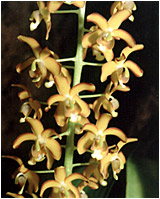 Eriopsis
biloba (photo:SA)
Eriopsis
biloba (photo:SA) |
Once
considered as poor in orchids, this myth has been changing and from this
region come the most beautiful species of the Catasetineas: Catasetum,
Cycnoches , Mormodes, Clowesia. Almost the totality of Mormodes
and Cycnoches occur in Amazon region. The genus with a great number
of species is Catasetum which can be find in all different habitats
in this vast ecosystem. "... The Brazilian Amazon is home of 6 species of Cattleya: Cattleya violacea, eldorado, luteola, lawrenceana, jenmanii and araguaiensis". |
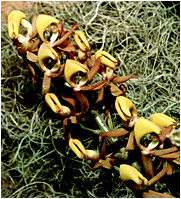 Mormodes topuayense (photo:SA) |
| (Kleber Lacerda, in Amazon Discovery of New Species and Extinction - Cattleya, The Queen of Flowers, Brazilian Orchids, Sodo Publishing) and two natural hybrids Brasscattleya x rubyi Braga (Brassavola martiana Lindl. x Cattleya eldorado Linden ex Van Houtt) and Cattleya x brymeriana Rchb. f. [Cattleya eldorado Linden ex Van Houtte x Cattleya violacea (HBK) Rolfe]. |
| Dryland
Forest of Amazon Corresponding to the most area of the Amazon basin, there are the so called Dryland Forest of Amazon (matas de terra firme - dense rain forest) where the trees can reach 50m height. The crowns of those trees are so close that makes difficult the penetration of sunlight. So the most exigent genera regarding to luminosity and ventilation, look for the crown of the most high trees and the less exigent are settled down in lower parts. Although it is not the richer habitat of orchids in this region, there are many interesting orchids occurring there. Catasetum aculeatum, albovirens, aripuanense, ariquemense, barbatum, callosum, complanatum, deltoideum, denticulatum, ferox,galeritum, garnettianum, gnomus, longifolium, matogrossense, rondonense, saccatum, semicirculatum, rivularium, tigrinum, Batemania colleyi, Cattleya luteola and violacea, Cochleanthes, Maxillaria species, Mormodes hirsutissimum, Paphinia cristata and grandiflora (shady and humid wood), Pleurothallis, Scaphyglottis amazônica, Stelis, Trigonidium, Trichocentrum album-coccineum are some of the orchids that occur in this habitat. |
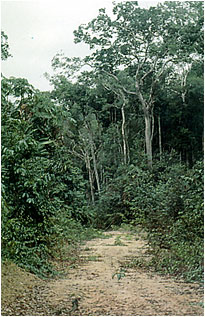 Degraded dryland forest (photo:FM) |
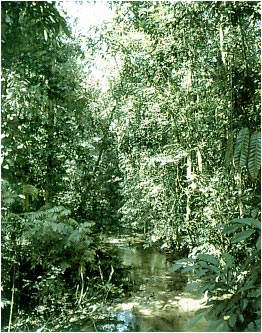 Small igarapé (photo:FM) |
Those
woods are not exposed to frequent flood but they have a great number of rivers and creeks called "igarapés". 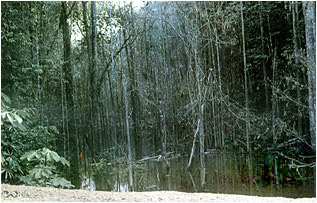 When there are lakes formed by the damming of igarapés, the trees which are not adapted to live in such conditions (in the water) die and fall down, allowing the sunlight gets inside the woods. |
| Anyway,
the Amazon region is not homogenous and inside it there are many other different
kinds of habitats with their own characteristics and different climatic
conditions. There are the "woods of várzea" and "woods of igapó" (border flooded woods), the Central Amazon Campinas (Woodlands) or campinaranas (which means false fields) and the cerrado (savannah). |
| In the Central Amazon Campinas (Woodlands), the trees are more sparse distributed allowing a stronger luminosity that can reach the ground and the trees form authentic suspended gardens, such the trunks of Macucu tree (Aldina heterophylla) that also gives shelter to the species that need shady environment. Cattleya eldorado finds its home in this tree, growing in the branches receiving, in this way, a not too strong luminosity. In shady and humid places, grows the Epidendrum paniculatum. |
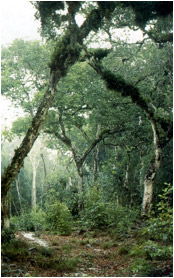 Transition area between drayland forest and woodland (photo:FM) |
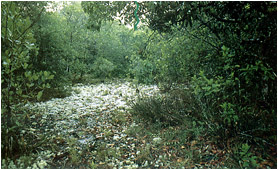 Open woodland (campina) (photo:FM) 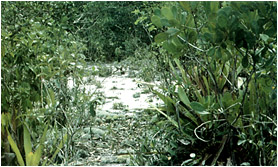 Open woodland with sandy soil (photo:FM) |
| Small
orchids are also present in the region and Pleurothallis picta and Pleurothallis
grobyi are the most common species of this genus. Some orchids that grow in
this habitat: Acacallis cyanea, Braemia vittata (Polycynis vittata), Brassavola martiana, Brassocattleya rubyi, Bulbophyllum setigerum, Catasetum barbatum, callosum, ciliatum, cristatum, discolor, galeritum, issasensis, longifolium, macrocarpum, pileatum, parguazense, tigrinum, Cattleya eldorado, violacea, Caularthron bicornutum, Cyrtopodium falcilobum, Dichaea anchoraelabia, pendula, tenuis, Encyclia tarumana, apuahensis, Epidendrum klotzschianum, nocturnum, Eriopsis biloba, Liparis nervosa, Masdevallia peruviana,Maxillaria amazonica, camaridii, crassifolia, grobyoides, huebneri, notylioglossa, pendens, uncata, villosa, Notylia cordiglossa, Octomeria amazonica and grandiflora, Orleanesia amazonica, yauperensis, Ornithidium parviflorum, Pleurothallis kerri, lanceana, miqueliana, spiculifera, Prescottia foliosa, stachyoides, Prosthechea fragrans, Rodriguezia lanceolata, leena, Rudofiella aurantiaca, Scaphyglottis huebneri, sickii, Scuticara steelii, Sobraslia infundibuligera, liliastrum macrophylla, Stellis,Trigonidium tenue, Vanilla pompona, Xerorchis amazonica, Zygopetalum labiosum. (This list is not complet and the information has been mainly extracted from the article written by Pedro Ivo Soares Braga, in Grasslands Orchids of the Brazilian Amazon Region, Francisco Miranda and Kleber Lacerda - see the bibliography, please). |
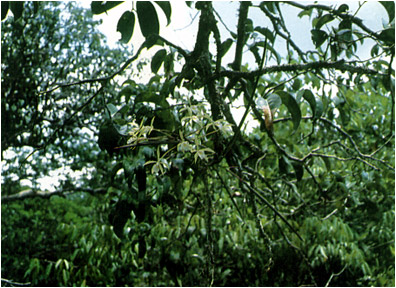 Environment well illuminated - Brassavola martiana (photo:FM) |
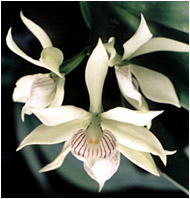 Prosthechea fragans (photo:SA) |
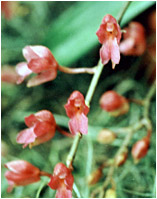 Rodriguezia lanceolata (photo:SA) |
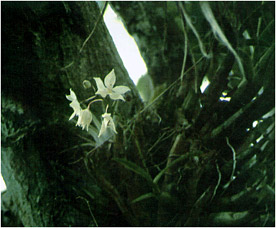 Caularthron bicornutum (photo:FM) |
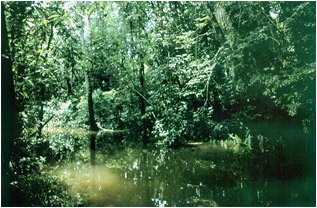 |
In the iguarapés, igapós e várzeas, the humidity is high due the aquatic influence but the luminosity varies a lot, there are deep and medium shady places. Some areas are not permanently flooded such as the "várzeas" that are inundated only during the flood season where the trees form isolate and well opened groups allowing the penetration of the luminosity. Thus giving appropriate conditions to the occurrence of those orchids which are more exigent regarding to the luminosity. | ||
| Typical Igarapé, with flood borders (photo:FM) |
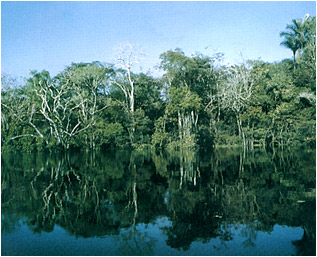 Igapó wood (photo:FM) |
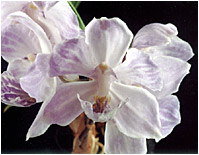 Acacallis cyanea photo:SA) |
In the igapós, occurs one of the most beautiful species of the region, Acacallis
cyanea (in flooded woods), growing near the water and staying submerged
part of the year, such as Galeandra devoniana. Those orchids which
need more light look the top of the trees or the borders of the wood, others
not too much exigent, appear in more shady areas. There, we can find Coryanthes maculata and macrantha, Gongora, Mormodes, Cattleya violacea, Caulorthron bicornutum, Oncidium cebolleta, lanceanum, nanum, Schomburgkia crispa, Brassia species, |
| Bifrenaria longicornis, many species of Catasetum such as aculeatum, barbatum, ciliatum, garnettianum, gnomus, issasensis, juruenense, kleberianum, lanceatum, longifolium, pulchrum, rolfeanum, rondonense, saccatum, tigrinum rolfenaum, rivularium, tigrinum, stenoglossum, Mormodes amazonicum, buccinator, Psygmorchis pusilla, Zygosepalum labiosum, Zygopesapulum lindeniae, etc. |
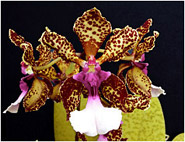 |
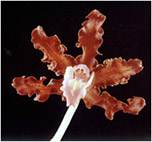 |
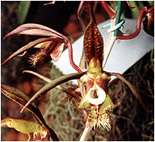 |
|
Oncidium lanceanum (photo:SA) |
Schomburgkia
crispa (photo:SA) |
Catasetum saccatum (photo:SA) |
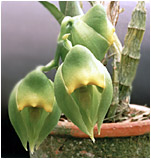 Catasetum macrocarpum (photo:SA) |
The Cerrado (savannah) also appears covering part of the states of Tocantins, Pará, Maranhão, Mato Grosso, Rondônia e Roraima, with the temperature and vegetation characteristics of the savanna of Central Plateau. Among many orchids, there are Catasetum barbatum, macrocarpum, albovirens, carolinianum, confusum, galeritum, Cattleya araguaiensis. | 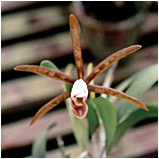 Cattleya araguaiensis (photo:SA) |
| Besides those habitats, there also are the dense forests which cover the mountainous region with altitude at about 2.000m and then the size of the vegetation is reduced. Low temperature and high humidity allow a very rich Orchidaceae flora mainly the so called micro-orchids. |
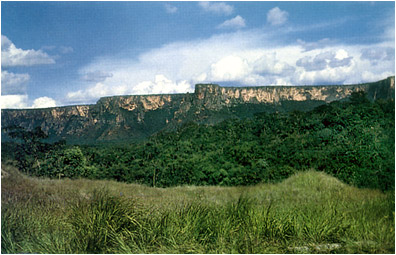 Chapada dos Parecis (photo:FM) |
There are also the borders regions where occur Acineta alticola, Catasetum ariquemense, bicallosum, denticulatum, osculatum, lanceatum, pileatum, saccatum, semicirculatum, stenoglossum, Cattleya lawrenceana, violacea, Chaubardi klugii, Cyncoches haagii, Galeandra stangeana, Lycaste macrobulbon, Macradenia multiflora, Mormodes densiflorum, elegans, hoehnei, Sobralia rondoni (Francisco Miranda, in Orchids from the Brazilian Amazon). |
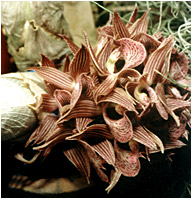 Mormodes hoehnei (photo:SA) 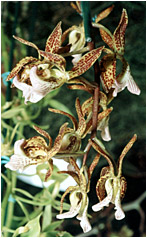 Mormodes aurantiaca (photo:SA) |
While the orchids from Atlantic Forest have been studying since long time
ago, in spite of the work done by some researchers, only in the XX century,
the studies about the orchids from Amazon region have had a great upswing due to
the studies done by Francisco Miranda, Kleber Garcia, João Batista F. da
Silva and Pedro Ivo Braga, between others. We have, nowadays, a bigger knowledge about the flora orchidaceae in that region. Curiously, there is in the south of the state of Bahia and north of the state of Espírito Santo, an evergreen forest "hileiana" similar to the drylands of Amazon region, where rains a lot and which vegetation presents many species in common with the true "Hyleia" which height can get 40m. A true Amazon territory placed in southeast. Some orchids are also in common: Cycnoches, Chaurbardia, Coryanthes, Brassia bidens, stellis endresii, Maxillaria robusta, Maxillaria nasuta, Pelexia maculata. |
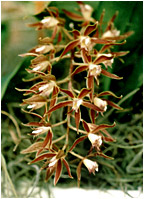 Macradenia multiflora (photo:SA) 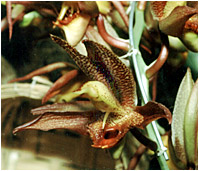 Catasetum osculatum photo:SA) |
| The
Amazon forest has been subject of former Orchid News: Nº 6 - Interview with Francisco Miranda Nº 16 - Pedro Ivo Braga - Cattleya Eldorado Nº 4 (Forum) - Interview with Dr. Francisco Silva concerning the influence of the clear and dark rivers in the flora. |